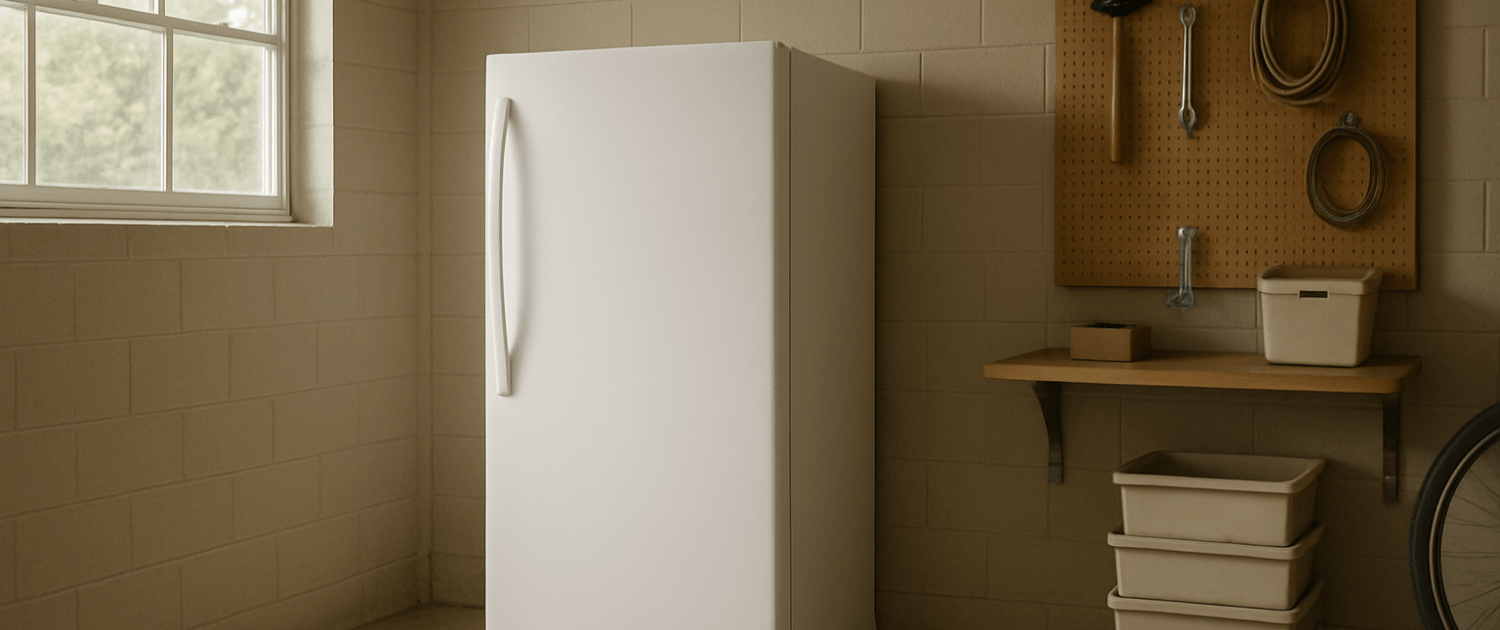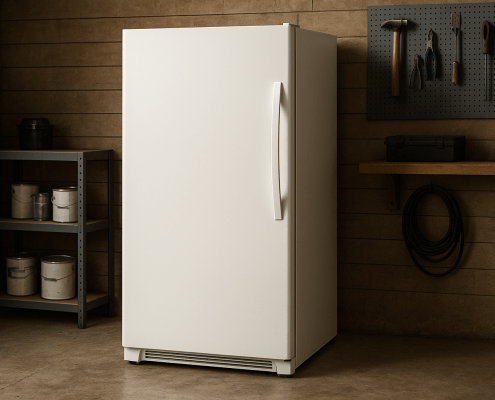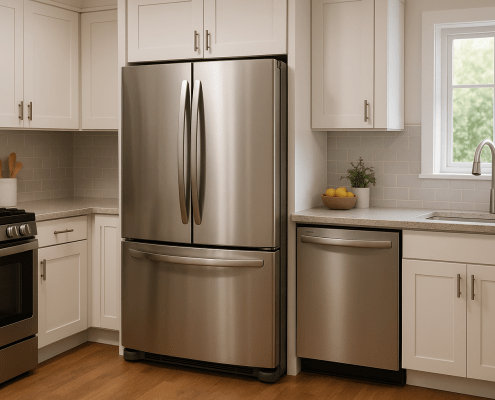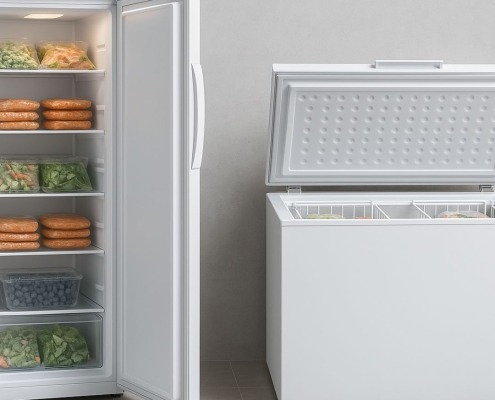Why Your Frigidaire Upright FREEZER Isn’t Keeping Things COLD
Steven E / Thursday October 30, 2025
Looking for the right part? Enter your appliance model number below to find the exact match and get your appliance running like new again!
Nothing’s worse than opening your freezer and finding thawed food instead of ice-cold storage. If your Frigidaire upright freezer isn’t keeping things cold, don’t panic! Most cooling problems come down to simple issues. Let’s break down the most common causes and what you can do to fix them fast.
Start with the Basics: What’s Running and What’s Not
The very first step in troubleshooting a freezer that won’t cool is simple: listen. What you hear (or don’t hear) can tell you a lot about what’s going on inside.
- Is the evaporator fan motor running?
- Is the compressor running?
- Are both silent?
If the evaporator fan isn’t running but you can hear the compressor humming, the fan might be the culprit.
If the fan is running but the compressor isn’t, you could be looking at a control board issue or a problem with the start relay.
Listening carefully saves time and helps you focus your efforts where they matter most.
Tools You’ll Need
Before diving in, make sure you have the right tools for the job:
- Multimeter
- Phillips-head screwdriver
- Flathead screwdriver
- 1/4-inch and 5/16-inch nut drivers
- Putty knife
And most importantly, always unplug your freezer or turn off the breaker before you start working. Safety first.
Checking the Frost Pattern on the Evaporator Coils
Once you’ve unplugged the freezer and removed the shelves, take off the evaporator cover with your Phillips screwdriver.
Now, take a look at the coils:
- Frost only halfway down: This usually means a sealed system issue, which is more complex.
- Coils completely packed with frost: That means your freezer isn’t defrosting properly.
If the coils look evenly frosted from top to bottom, that’s good news; it means the cooling system itself is probably fine. The issue is likely somewhere in the airflow or electrical system.
Testing the Evaporator Fan Motor
If your coils look fine but the fan isn’t spinning, it’s time to test the evaporator fan motor. This part circulates cold air through the freezer, so if it fails, temperatures will rise fast.
Here’s what to do:
- Unplug the motor connector.
- Set your multimeter to AC voltage.
- Plug the freezer back in and test for power at the connector.
If you have voltage but the motor doesn’t spin, the motor is bad and needs replacing. If you don’t have voltage, you could have a broken wire or a control board issue.
Checking the Defrost Bimetal and Heater Element
If you saw heavy frost buildup earlier, the defrost system deserves a closer look. Two key parts work together here: the defrost bimetal thermostat and the defrost heater element.
Here’s how to test them:
- Unplug the freezer.
- Disconnect both sides of the heater plug.
- Set your multimeter to resistance (ohms).
- Test across the heater and bimetal circuit.
You should get a reading around 10,000 to 12,000 ohms.
- If you get a number way off from that range, replace both the heater and the bimetal.
- If the reading is fine, the issue might be with the control board, not the parts themselves.
Testing and Replacing the Control Board Interface
On some Frigidaire upright freezers, the control interface is located right on the front door. If the display looks odd, like digits missing or dimly lit, that’s often a sign the interface itself has failed.
To replace it:
- Unplug the freezer.
- Use a putty knife to carefully pry out one side of the control panel. (You can use tape on the blade to protect the paint.)
- Disconnect the single plug on the back.
- Reconnect it to the new interface.
- Snap the new one in place.
When a display is blank or partially showing, that’s reason enough to swap it out. It’s a simple, satisfying fix that can restore control and visibility.
Testing the Main Control Board
If your freezer isn’t sending power to major parts, like the fan motor, compressor, or defrost system, the main control board could be the issue.
You’ll usually replace this only after confirming that:
- Power isn’t reaching a motor or relay
- The freezer isn’t cycling into defrost
- Other tested parts check out fine
The control board acts as the “brain” of your freezer. When it fails, the entire system can seem dead or erratic.
Testing the Compressor and Start Relay
If your freezer’s compressor isn’t running, or if it just clicks and stops, the start relay or compressor itself could be the problem.
Access the compressor:
- Remove the rear cover panel.
- Find the start relay mounted on the side of the compressor.
Check for power:
- Unplug the relay connector.
- Plug the freezer back in.
- Test for 120 volts AC at the connector.
- If you don’t have voltage, the control board might be at fault.
- If you do have voltage, move on to testing the relay.
Test the relay:
- Unplug the freezer again.
- Remove the metal clamp and pull the relay straight off.
- Set your multimeter to continuity.
- Test between the common pin hole and the opposite terminal.
- No continuity: Replace the relay.
- Continuity present: Move on to test the compressor windings.
Test the compressor windings:
- Measure from the common pin to each side pin.
- Add the two readings together.
- They should match the reading between the two side pins.
If the readings match, the compressor might be fine electrically, though it could still be mechanically locked up.
Testing the Temperature Sensor
Your freezer’s temperature sensor monitors internal temperature and tells the control board when to turn the cooling system on or off. If it’s faulty, your freezer may not know when to chill.
In most upright Frigidaire models, the sensor sits behind the evaporator panel. It’s hardwired, meaning there’s no plug connector, but you can test it from the control board underneath the freezer.
- Tilt the freezer slightly back against the wall, never sideways, as compressor oil can leak.
- Locate the black and red wires going to the board.
- Measure resistance across them using your multimeter.
The resistance will vary depending on the freezer’s actual temperature, so compare your readings to a temperature-resistance chart for your model.
If the reading doesn’t match expected values, replace the temperature sensor.
A Quick Recap of the Troubleshooting Process
Here’s a handy summary of what you’ve learned:
- Listen first. Identify what’s running and what’s not.
- Check the frost pattern. It reveals a lot about the system’s health.
- Test the evaporator fan motor. If it’s not spinning with power present, replace it.
- Inspect the defrost system. Check the bimetal and heater element for correct resistance.
- Evaluate the control interface. Dim or partial digits usually mean it’s time for a new one.
- Test the control board. Confirm voltage is being sent to all key parts.
- Check the compressor and start relay. Make sure they’re getting power and showing continuity.
- Test the temperature sensor. Verify it’s reading accurately based on temperature.
- Replace the faulty part. Whether it’s the fan motor, control board, or relay, swap it out and retest.
Where To Find Us
Congratulations! You’ve just taken a major step toward restoring your Frigidaire upright freezer to full working order.
If you need any replacement parts for your appliances, you can enter your model number at AppliancePartsPros.com to locate and order them quickly. Most orders arrive in just two business days, and we have tons of great information in our repair help section and YouTube videos to help you troubleshoot.
Stay connected with the latest DIY tips, tutorial videos, and repair guides by following us on Facebook, Instagram, and Twitter. We love hearing about your repair stories and successes. If you need more help or want personalized guidance, feel free to contact or call us at 877-477-7278. We’re ready to help you take on your next project with confidence!
Since 1999, AppliancePartsPros.com has helped millions of people repair their broken appliances by providing high-quality original parts at well below retail prices, free support and troubleshooting, and award-winning customer service from an expert, friendly, US-based customer support team!
With nearly a decade of experience in providing top-notch customer service regarding appliance parts and repair, Steven enjoys sharing practical advice, troubleshooting tips, and interesting information to help readers stay informed.






Leave a Reply
Want to join the discussion?Feel free to contribute!